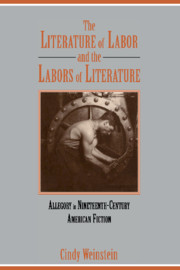 The Literature of Labor and the Labors of Literature
The Literature of Labor and the Labors of Literature Published online by Cambridge University Press: 06 July 2010
The question of Hawthorne's relation to allegory has excited and plagued critics of Hawthorne ever since his short stories first appeared in the early 1830s. It even bothered Hawthorne, who in 1854 wrote to his publisher James T. Fields, “Upon my honor, I am not quite sure that I entirely comprehend my own meaning in some of these blasted allegories.” Following Hawthorne's own lead, contemporary readers continue to wrestle with the problem of Hawthorne and allegory and have come up with a variety of compelling explanations, many of which assume as their point of departure that Hawthorne was indeed experimenting with traditional allegory to create a new kind of allegory. The agreement ends there, as one cultural critic maintains that Hawthorne “modified] a sacrosanct Puritan form by mixing it with contemporary themes and styles” in order to “suit modern needs,” and another critic, one with a more formalist perspective, argues that Hawthorne “apparently adopts the allegorical mode in order to turn it against allegorical intentions. ” Although both of these views contribute to a greater understanding of Hawthorne's recasting of traditional allegory, this reading will suggest yet another explanation, in which allegorical characters reveal themselves as dialogically engaged with one of the nineteenth century's most powerful technologies of producing personhood - the developing market economy in antebellum America. If, on the one hand, allegory functions as a reminder of traditional texts (Bunyan would, of course, be the most obvious candidate in the case of Hawthorne) and a repository of traditional values, it becomes, on the other hand, a departure point for radically untraditional configurations of personhood that bear little relation to the religious world of Bunyan.
To save this book to your Kindle, first ensure [email protected] is added to your Approved Personal Document E-mail List under your Personal Document Settings on the Manage Your Content and Devices page of your Amazon account. Then enter the ‘name’ part of your Kindle email address below. Find out more about saving to your Kindle.
Note you can select to save to either the @free.kindle.com or @kindle.com variations. ‘@free.kindle.com’ emails are free but can only be saved to your device when it is connected to wi-fi. ‘@kindle.com’ emails can be delivered even when you are not connected to wi-fi, but note that service fees apply.
Find out more about the Kindle Personal Document Service.
To save content items to your account, please confirm that you agree to abide by our usage policies. If this is the first time you use this feature, you will be asked to authorise Cambridge Core to connect with your account. Find out more about saving content to Dropbox.
To save content items to your account, please confirm that you agree to abide by our usage policies. If this is the first time you use this feature, you will be asked to authorise Cambridge Core to connect with your account. Find out more about saving content to Google Drive.